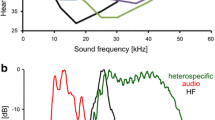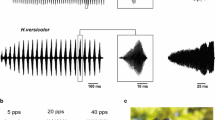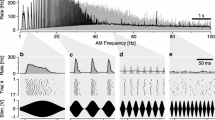Summary
The functional organization of the afferent auditory system was studied in the bushcricketMygalopsis marki. The acoustic stimuli were computer simulated signals equivalent to the song of a male recorded at various distances in the habitat.
-
1.
Individual receptor fibres have different tuning and absolute sensitivities and therefore differ in the specific distance at which they start to respond (‘threshold distance’, Fig. 3). This resulted in a range-fractionation in the distance of a conspecific signaller.
-
2.
The target areas of receptor fibre endings in the auditory neuropil of the prothoracic ganglion differed in the rostro-caudal and dorso-ventral axis (Fig. 4). This tonotopic arrangement and the range-fractionation of tympanic receptor fibres result in a specific spatial distribution of afferent nervous activity in the neuropil. The distribution depends on the distance away from a singing conspecific male (Fig. 5).
-
3.
Distance response characteristics of interneurons differed in both their shape and ‘threshold distance’ (Fig. 6). Certain neurons showed maximum responses which corresponded to an intermediate distance. These responses are based on a frequency-dependent synaptic interaction of excitation and inhibition (Fig. 7). The different distance response characteristics of interneurons can be related in part to the dendritic branching pattern within the neuropil.
Similar content being viewed by others
References
Bailey WJ (1985) Acoustic cues for female choice in bushcrickets (Tettigoniidae). In: Kalmring K, Elsner N (eds) Acoustic and vibrational communication in insects. Parey, Berlin Hamburg, pp 101–111
Bailey WJ, Thiele DR (1983) Male spacing behavior in the Tettigoniidae: An experimental approach. In: Gwynne DT, Morris GK (eds) Orthopteran mating systems. Sexual competition in a diverse group of insects. Westview Press, Boulder, Colorado, pp 163–184
Boyan GS (1984) Neural mechanisms of auditory information processing by identified interneurons in Orthoptera. J Insect Physiol 30:27–41
Campbell DJ, Shipp E (1979) Regulation of spatial pattern in populations of the field cricketTeleogryllus commodus (Walker). Z Tierpsychol 51:260–268
Huber F (1983) Neural correlates of orthopteran and cicada phonotaxis. In: Huber F, Markl H(eds) Neuroethology and behavioral physiology. Springer, Berlin Heidelberg New York, pp 108–135
Kalmring K (1975) The afferent auditory pathway in the ventral cord ofLocusta migratoria (Acrididae) I. Synaptic connectivity and information processing among the auditory neurons of the ventral cord. J Comp Physiol 104:103–141
Kalmring K, Lewis B, Eichendorf A (1978) The physiological characteristics of the primary sensory neurons of the complex tibial organ ofDecticus verrucivorus L. (Orthoptera, Tettigoniidae). J Comp Physiol 127:109–121
Keuper A, Kühne R (1983) The acoustic behaviour of the bushcricket,Tettigonia cantans: 2. Transmission of airborne sound and vibration signals in the biotope. Behav Processes 8:125–146
Latimer W (1980) Song and spacing inGampsocleis glabra. J Nat Hist 14:201–213
Latimer W, Lewis DB (1986) Song harmonic content as a parameter determining acoustic orientation behaviour in the cricketTeleogryllus oceanicus (Le Guillou). J Comp Physiol A 158:583–591
Latimer W, Sippel M (1987) Acoustic cues for female choice and male competition inTettigonia cantans. Anim Behav (in press)
Lewis DB, Seymour C, Broughton WB (1975) The response characteristics of the tympanal organs of two species of bushcrickets and some studies of the problem of sound transmission. J Comp Physiol 104:325–351
Meixner AJ, Shaw KC (1979) Spacing and movement of singingNeoconocephalus nebrascensis males (Tettigoniidae: Copophorinae). Ann Entomol Soc Am 72:602–606
Michelsen A, Larsen ON (1983) Strategies for acoustic communication in complex environments. In: Huber F, Markl H (eds) Neuroethology and behavioral physiology. Springer, Berlin Heidelberg New York, pp 321–332
Morris GK, Kerr GE, Gwynne DT (1975) Calling song function in the bog katydid,Metrioptera sphagnorum (Walker) (Orthoptera, Tettigoniidae): Female phonotaxis to normal and altered song. Z Tierpsychol 37:502–514
Nocke H (1972) Physiological aspects of sound communication in crickets (Gryllus campestris L.). J Comp Physiol 80:141–162
Oldfield BP (1983) Central projections of primary auditory fibres in Tettigoniidae (Orthoptera: Ensifera). J Comp Physiol 151:389–395
Oldfield BP (1984) Physiology of auditory receptors in two species of Tettigoniidae (Orthoptera: Ensifera). Alternative tonotopic organization of the auditory organ. J Comp Physiol A 155:689–696
Oldfield BP, Hill KG (1983) The physiology of ascending auditory interneurons in the tettigoniidCaedicia simplex (Orthoptera: Ensifera): response properties and a model of integration in the afferent auditory pathway. J Comp Physiol 152:495–508
Otte D, Joern A (1975) Insect territoriality and its evolution: population studies of desert grasshoppers on creosote bushes. J Anim Ecol 44:29–54
Popov AV (1973) Frequency selectivity of the reaction of auditory neurons in the 1st thoracic ganglion of the cricketGryllus bimaculatus. J Evol Biochem Physiol 9:265–277
Rheinlaender J (1975) Transmission of acoustic information at three neuronal levels in the auditory system ofDecticus verrucivorus (Tettigoniidae: Orthoptera). J Comp Physiol 97:1–55
Rheinlaender J, Römer H(1980) Bilateral coding of sound direction in the CNS of the bushcricketTettigonia viridissima L. (Orthoptera, Tettigoniidae). J Comp Physiol 140:101–111
Rheinlaender J, Römer H (1986) Insect hearing in the field. I. The use of identified nerve cells as ‘biological microphones’. J Comp Physiol A 158:647–651
Roeder KD (1974) Response of the less sensitive acoustic sense cells in the tympanic organ of some noctuid and geometrid moths. J Insect Physiol 20:55–66
Römer H (1976) Die Informationsverarbeitung tympanaler Rezeptorelemente vonLocusta migratoria (Acrididae, Orthoptera). J Comp Physiol 109:101–122
Römer H (1983) Tonotopic organisation of the auditory neuropile in the bushcricketTettigonia viridissima. Nature 306:60–62
Römer H (1985) Anatomical representation of frequency and intensity in the auditory system of Orthoptera. In: Kalmring K, Elsner N (eds) Acoustic and vibrational communication in insects. Parey, Berlin Hamburg, pp 25–32
Römer H, Bailey WJ (1986) Insect hearing in the field. II. Spacing behaviour and related acoustic cues for the maleMygalopsis marki (Tettigoniidae). J Comp Physiol A 159:627–638
Römer H, Marquart V (1984) Morphology and physiology of auditory interneurons in the metathoracic ganglion of the locust. J Comp Physiol A 155:249–262
Römer H, Seikowski U (1985) Responses to model songs of auditory neurons in the thoracic ganglia and brain of the locust. J Comp Physiol A 156:845–860
Schatral A, Latimer W, Broughton WB (1984) Spatial dispersion and agonistic contacts of male bush crickets in the biotope. Z Tierpsychol 65:201–214
Suga N (1960) Peripheral mechanism of hearing in locust. Jpn J Physiol 10:533–546
Suga N (1961) Functional organization of two tympanic neurons in noctuid moths. Jpn J Physiol 11:666–667
Suga N (1984) The extent to which bisonar information is represented in the bat auditory cortex. In: Edelmann GM, Gall WE, Cowan WM (eds) Dynamic aspects of neocortical function. John Wiley & Sons, New York, pp 315–373
Suga N, Manabe T (1982) Neural basis of amplitude-spectrum representation in the auditory cortex of the mustache bat. J Neurophysiol 47:225–255
Thiele DR (1981) Mechanisms of acoustic spacing within populations of the tettigoniidMygalopsis marki. PhD thesis, University of Western Australia
Thiele DR, Bailey WJ (1980) The function of sound in male spacing behaviour in bushcrickets (Tettigoniidae, Orthoptera). Aust J Ecol 5:275–286
Wohlers DW, Huber F (1978) Intracellular recording and staining of cricket auditory interneurons (Gryllus campestris L.,Gryllus bimaculatus DeGeer). J Comp Physiol 127:11–28
Author information
Authors and Affiliations
Rights and permissions
About this article
Cite this article
Römer, H. Representation of auditory distance within a central neuropil of the bushcricketMygalopsis marki . J. Comp. Physiol. 161, 33–42 (1987). https://doi.org/10.1007/BF00609453
Accepted:
Issue Date:
DOI: https://doi.org/10.1007/BF00609453




